Indian Polity: July 2024 UPSC Current Affairs | PSIR Optional for UPSC PDF Download
NITI Aayog SDG India Index 2023-24

Why in News?
The NITI (National Institution for Transforming India) Aayog has released its latest Sustainable Development Goal (SDG) India Index for 2023-24, showing significant progress in sustainable development across states and union territory of India.
What is the SDG India Index?
About:
- The SDG India Index is a tool developed by NITI Aayog to measure and track India's progress towards the SDGs set by the United Nations.
- The Index supports the localization of SDGs, encouraging states to integrate these goals into their development plans.
- It serves as a benchmark for policymakers to identify gaps and prioritize actions towards achieving sustainable development by 2030.
Methodology:
- The Index assesses the performance of states and union territories (UTs) across 16 SDGs using a set of indicators aligned with national priorities.
- It measures national progress using 113 indicators aligned to the National Indicator Framework.
- Goal-wise scores are computed for the 16 SDGs, and overall composite scores are derived for each State/UT.
Impact on Development:
- The Index promotes competitive and cooperative federalism, encouraging States and UTs to learn from each other and close outcome-based gaps.
- It provides a comprehensive analysis of progress, highlighting achievements and areas needing improvement.
- India fully integrated the SDGs into its national development strategies and is proud of its SDG localization model based on institutional ownership, collaborative competition, capacity building, and a whole-of-society approach.
What are the Key Highlights of the SDG India Index for 2023-24?
Overall Progress:
- India's overall SDG score improved to 71 in 2023-24 from 66 in 2020-21 and 57 in 2018. All states have shown improvement in overall scores. Progress has been largely driven by targeted government interventions in poverty reduction, economic growth, and climate action.
Top Performers:
- Kerala and Uttarakhand emerged as the best-performing states, each scoring 79 points.
- Lowest Performer:
- Bihar lagged behind with a score of 57 points, followed by Jharkhand at 62 points.
- Front-Runner States:
- 32 states and union territories (UTs) are in the front-runner category, with 10 new entrants including Arunachal Pradesh, Assam, Chhattisgarh, and Uttar Pradesh.
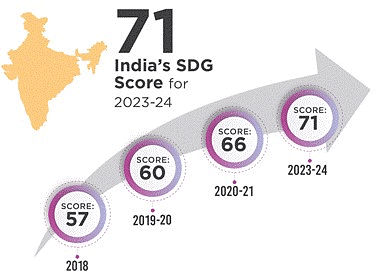
Government Interventions Contributions to SDG Progress:
- Pradhan Mantri Awas Yojana: Over 4 crore houses built.
- Swachh Bharat Mission: 11 crore toilets and 2.23 lakh community sanitary complexes constructed.
- Ujjwala Yojana: 10 crore LPG connections provided.
- Jal Jeevan Mission: Tap water connections in over 14.9 crore households.
- Ayushman Bharat-PMJAY:
- Over 30 crore beneficiaries.
- Access to 150,000 Ayushman Arogya Mandir which offer primary medical care and provide affordable generic medicines.
- PM Mudra Yojana:
- 43 crore loans sanctioned.
- Saubhagya Scheme:
- 100% household electrification.
- Renewable Energy:
- Solar power capacity increased from 2.82 GW to 73.32 GW in a decade.
- National Food Security Act (NFSA):
- Coverage of over 80 crore people.
- Direct Benefit Transfer (DBT):
- Rs. 34 lakh crore made through PM-Jan Dhan accounts.
- Skill India Mission:
- Over 1.4 crore youth being trained and upskilled and has reskilled 54 lakh youth.
Specific SDGs
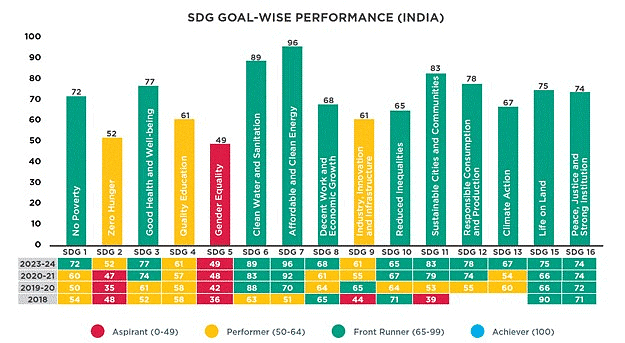
Goal 1: No Poverty
- Improved score from 60 in 2020-21 to 72 in 2023-24. 99.7% were offered employment of the persons demanding employment under MGNREGA in 2023-2024.
Goal 2: Zero Hunger
- Improvement in overall composite score from Aspirant to Performer category. 99.01% beneficiaries covered under National Food Security Act (NFSA), 2013.
Goal 3: Good Health and Well-being
- Overall score improved from 52 in 2018 to 77 in 2023-24. 93.23% children aged 9-11 months are fully immunized, and the Maternal Mortality Rate per 1,00,000 live births stands at 97.
Goal 4: Quality Education
- Adjusted Net Enrolment Rate (ANER) for elementary education is 96.5% for 2021-22. 88.65% of schools have access to both electricity and drinking water.
- 100% parity between females and males in Higher Education (18-23 years).
Goal 5: Gender Equality
- Overall score improved from 36 in 2018 to 49 in 2023-24. Sex ratio at birth (females per 1,000 males) stands at 929.
Goal 6: Clean Water and Sanitation
- Significant improvement in score from 63 in 2018 to 89 in 2023-24. 99.29% of rural households have improved their source of drinking water.
- 94.7% of schools have functional toilets for girls.
Goal 7: Affordable and Clean Energy
- Highest score amongst all SDGs also significant improvement from 51 in 2018 to 96 in 2023-24.
- 100% households have access to electricity under the Saubhagya Scheme.
- Significant improvement in households have clean cooking fuel (LPG + PNG) connections from 92.02% (2020) to 96.35% (2024)
Goal 8: Decent Work and Economic Growth
- 5.88% annual growth rate of India's GDP per capita at constant prices in 2022-23.
- Reduction in unemployment rate from 6.2% in 2018-19 to 3.40% in 2022-23.
Goal 9: Industry, Innovation and Infrastructure
- Improvement in score from 41 in 2018 to 61 in 2023-24. 99.70% of targeted habitations connected with all-weather roads under PM Gram Sadak Yojana.
Goal 10: Reduced Inequalities
- Decrease in points from 67 in 2020-21 to 65 in 2023-24.
- 45.61% seats of Panchayati Raj Institutions held by women. 28.57% representation of SC/ST persons in state legislative assemblies.
Goal 11: Sustainable Cities and Communities
- Significant improvement in score from 39 in 2018 to 83 in 2023-24. The percentage of municipal solid waste processed has increased from 68% in 2020 to 78.46% in 2024.
- 97% of wards have 100% door to door waste collection.
Goal 12: Responsible Consumption and Production
- 91.5% of biomedical waste generated is treated in 2022.
- 54.99% hazardous waste recycled/utilized in 2022-23.
Goal 13: Climate Action
- Drastic improvement from 54 (Performer category) in 2020-21 to 67 (Front Runner category) in the SDG India Index 4 (2023-24).
- Disaster preparedness score as per Disaster Resilience Index stands at 19.20.
- Improvement in electricity generation from renewable energy from 36.37% in 2020 to 43.28% in 2024.
- 94.86% of industries comply with environmental standards.
Goal 14: Life Below Water
- Goal 14 has not been included in the calculation.
Goal 15: Life on Land
- Score improved from 66 in 2020-21 to 75 in 2023-24. Nearly 25% of geographical area under forests and tree cover.
Goal 16: Peace, Justice and Strong Institutions
- 95.5% of the population is under Aadhaar coverage as of March 2024.
- 71.3% charge sheeting rate of IPC crimes as per NCRB 2022.
Overview of the Goals:
- The goals "No Poverty", "Decent Work and Economic Growth", and "Life on Land" showed the highest increase in points across states from 2020-21 scores, while "Gender Equality" and "Peace, Justice, and Strong Institution" had the smallest increase.
- "Reduced Inequalities" was the only goal to decrease in points from 67 in 2020-21 to 65 in 2023-24.
- This reduction reflects the distribution of wealth and suggests that in many parts of India, there are high levels of inequality, particularly in relation to employment opportunities at the lower end of the socioeconomic spectrum. The goal of reducing inequalities also includes addressing gender inequality in workforce participation.
- Gender Equality received the lowest score among all goals, with a marginal increase from the previous year. Issues such as sex ratio at birth, women owning land and assets, employment, and labor force participation rate are areas of concern, particularly in states with below 900 sex ratio at birth.
- Quality of Education goal increased by 4 points to 61, highlighting that some states, particularly in central India, still face challenges. The main issue in India is not access, but rather the quality of education, which impacts employment opportunities.
Mains Question
Evaluate the overall progress of India towards achieving the Sustainable Development Goals as reflected in the SDG India Index 2023-24. What factors have contributed to this progress?
Nine Years of Digital India Initiative
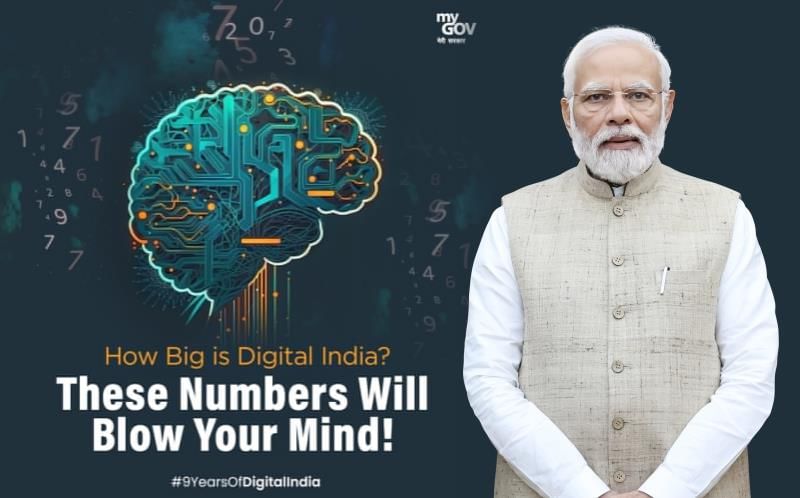
Why in News?
Recently, the Prime Minister highlighted the significant impact of Digital India initiatives, celebrating its successful nine-year journey. He described Digital India as a symbol of national empowerment, improving living standards and promoting transparency.
What is the Digital India Initiative?
About
Digital India was launched on 1 July 2015 by the Indian Government. This program builds on previous e-governance efforts that started in the mid-1990s but lacked coherence and interaction.
Objective
- Narrowing the Digital Divide: The initiative aims to reduce the gap between tech-savvy individuals and those with limited digital access.
- Promoting Digital Participation: It works towards ensuring equal access to digital technology benefits for all citizens, covering areas like education, healthcare, and government services.
- Stimulating Economic Development: By leveraging technological advancements and innovative solutions, Digital India seeks to drive economic growth nationwide.
- Elevating Living Standards: The program strives to enhance the overall quality of life for citizens through the strategic use of technology in various aspects of daily life.
Nine Pillars of Digital India Initiative
- Broadband Highways: Focuses on constructing extensive high-speed broadband networks nationwide to enhance connectivity and digital empowerment.
- Universal Access to Mobile Connectivity: Extending mobile coverage to remote areas, enabling all citizens to access mobile services and engage in the digital economy.
- Public Internet Access Programme: Establishment of Common Service Centres in underserved areas to provide affordable internet access, bridging the digital divide and promoting digital literacy.
- E-Governance, Utilize Technology to Streamline Government Services: Enhancing accessibility, efficiency, and transparency while boosting citizen engagement.
- E-Kranti: Platforms like MyGov.in facilitate the electronic delivery of government services to citizens, focusing on accessibility and operational efficiency.
- Information for All: Digitizing government records for online access and promoting open data initiatives to drive innovation and development.
- Electronics Manufacturing: Promoting local electronics manufacturing to reduce imports, create jobs, and support digital economic growth through manufacturing clusters and investment incentives.
- Information Technology (IT) for Jobs: Enhancing youth IT skills to meet industry demands through programs like Digital Literacy Mission and Skill India, emphasizing skill enhancement and employment in the IT sector.
- Early Harvest Programs: Include specific projects addressing immediate digital needs like online access to school certificates, digital attendance, and Wi-Fi in public spaces.
What are the Various Digital India Initiatives Taken for Digital India?
- Aadhaar: A biometric identification system assigning unique 12-digit identity numbers to residents.
- BharatNet: A project aiming to provide high-speed broadband connectivity to villages, enabling digital services in rural areas.
- Startup India: An initiative to promote entrepreneurship and support startups through incentives, funding, and mentoring.
- e-NAM: An online trading platform connecting agricultural markets for efficient sale of produce.
- Digital Locker: A cloud-based platform for securely storing and accessing important documents digitally.
- BHIM UPI: A digital payment system enabling secure peer-to-peer transactions using smartphones.
- eSign Framework: Facilitates online signing of documents using digital signatures.
- MyGov: A citizen engagement platform facilitating participation in governance and policy discussions.
- e-Hospital: Digitized hospital services including online registration and access to health records.
- SWAYAM
- UMANG App
- Smart Cities Mission
- Digital India Act (DIA), 2023
Challenges and Way Forward Concerning Digital India
- Bridging the Digital Divide: Implement initiatives like the PM-WANI scheme to establish public Wi-Fi networks, aiming for 2 million hotspots by 2024. Invest in 5G infrastructure for 40% population coverage by 2025.
- Digital Literacy: Enhance digital literacy by scaling up the Pradhan Mantri Gramin Digital Saksharta Abhiyan to train 60 million rural households by 2023. Integrate digital literacy programs in school curricula to increase the digitally literate population from 34% to 50% by 2025.
- Cybersecurity And Data Privacy Concerns: Implement the National Cyber Security Strategy to reduce cybercrime incidents by 50% by 2026 through strong legislation and robust privacy mechanisms.
- E-Governance Challenges: Enhance e-governance by implementing a unified digital identity system for all government services by 2024. Increase the number of services available through the UMANG app from 1,251 to 2,500 by 2025.
- Skills Gap: Address the skills gap by focusing on a national digital skills program to upskill professionals in emerging technologies; India will need 30 million digitally skilled professionals by 2026.
Mains Questions
Examine the Digital India initiatives, including the challenges they face and the measures needed to effectively address these challenges.
Defamation Case Against Wikipedia

Why in News?
Recently, news agency Asian News International (ANI) has taken legal action against Wikipedia, filing a case in the Delhi High Court. ANI alleges that Wikipedia has allowed defamatory content to remain on ANI's Wikipedia page, which they claim is false and damaging to their reputation and goodwill. They are seeking Rs 2 crore in damages.
Legal Basis for ANI's Case Against Wikipedia
- Section 2(1)(w) of the Information Technology (IT) Act, 2000 defines an "intermediary" as someone who handles electronic records on behalf of others, such as internet service providers, web-hosting services, and search engines.
- Section 79 of the IT Act, 2000 (Safe Harbour Clause) provides legal protection to intermediaries from liability for third-party content on their platforms.
- Section 79(2)(b) outlines conditions for safe harbor protection, including observing due diligence, not modifying transmitted information, and complying with government directives.
- Intermediary Guidelines and Digital Media Ethics Code, 2021, require intermediaries to promptly remove specified material upon government notification to retain safe harbor protection.
- Section 3 of the IT Act, 2000 allows subscribers to authenticate electronic records using digital signatures and asymmetric crypto systems.
Supreme Court Rulings Related to Wikipedia
- Ayurvedic Medicine Manufacturers Organisation of India v. Wikipedia Foundation Case, 2022: Dismissed petitions alleging defamation in a Wikipedia article, advising petitioners to edit the article or seek legal remedies.
- Hewlett Packard India Sales v. the Commissioner of Customs Case, 2023: The Supreme Court cautioned against relying on crowd-sourced platforms like Wikipedia for legal matters due to potential misinformation.
Maintenance Rights of Divorced Muslim Women
 Why in News?
Why in News?In the case of Mohd Abdul Samad v. the State of Telangana, 2024, the Supreme Court (SC) of India dismissed a petition challenging the applicability of Section 125 of the Criminal Procedure Code (CrPC) to a divorced Muslim woman.
What was the Petition About?
- The petition was filed by a Muslim man challenging a direction to pay interim maintenance to his divorced wife under Section 125 CrPC.
- The petitioner argued that the Muslim Women (Protection of Rights on Divorce) Act, 1986 should override the secular law of Section 125 CrPC.
- The petitioner claimed that the 1986 Act, being a special law, provided more comprehensive maintenance provisions and should therefore take precedence over the general provisions of Section 125 CrPC.
- The petitioner argued that Sections 3 and 4 of the 1986 Act, with a non-obstante clause, empower First Class Magistrates to decide matters of Maher and subsistence allowances.
- He insisted that family courts lack jurisdiction as the Act mandates Magistrates to handle these issues. The petitioner emphasised the wife's failure to submit an affidavit opting for CrPC provisions over the 1986 Act, as required by Section 5.
- It was argued that the 1986 Act implicitly repealed Section 125 CrPC for Muslim women due to its specific provisions, thus barring them from seeking relief under Section 125 CrPC.
What is the Muslim Women (Protection of Rights on Divorce) Act, 1986?
- Purpose: The Act was enacted to protect the rights of Muslim women who have been divorced by, or have obtained divorce from, their husbands. It provides for matters connected with or incidental to the protection of these rights.
- Provisions:
- A divorced Muslim woman is entitled to a reasonable and fair provision and maintenance from her former husband, to be paid within the iddat period.
- Iddat is a period, usually of three months, which a woman must observe after the death of her husband or a divorce before she can remarry.
- The Act also covers the payment of mahr (dower) and the return of properties given to the woman at the time of marriage.
- It allows a divorced woman and her former husband to choose to be governed by the provisions of sections 125 to 128 of the CrPC, 1973. If they make a joint or separate declaration to this effect at the first hearing of the application.
- Evolution: A Constitution bench of the SC had in its 2001 judgement in the case Danial Latifi & Another vs Union Of India upheld the constitutional validity of the 1986 Act and said that its provisions do not offend Articles 14, 15 and 21 of the Constitution of India.
Shabana Bano v. Imran Khan Case, 2009
- The SC reiterated that divorced Muslim women could claim maintenance under Section 125 of the CrPC, even beyond the iddat period, as long as they do not remarry.
- This affirmed the principle that the CrPC provision applies irrespective of religion.
What Does Section 125 of the CrPC Say?
- Section 125 of the CrPC mandates that a Magistrate of the first class may order a person with sufficient means to make a monthly allowance for the maintenance of:
- His wife, if she is unable to maintain herself.
- His legitimate or illegitimate minor child, whether married or not, unable to maintain itself.
- His legitimate or illegitimate adult child with physical or mental abnormalities or injuries that render them unable to maintain themselves.
- His father or mother, unable to maintain themselves.
What are the Supreme Court Observations?
- SC held that Section 125 CrPC applies to all women, not just married women. It emphasised that the provision would apply universally.
- The SC's judgement reaffirms the rights of divorced Muslim women to claim maintenance under Section 125 CrPC, ensuring legal parity and safeguarding constitutional guarantees of equality and non-discrimination.
- The Supreme Court dismissed the appeal, reaffirming that Muslim women can seek maintenance under Section 125 CrPC despite the existence of the 1986 Act.
- The Court noted that Section 3 of the 1986 Act, starting with a non-obstante clause, does not restrict the application of Section 125 CrPC, but rather provides an additional remedy.
Criteria For Classical Language

Why in news?
Recently, the Central government has decided to modify the criteria for granting classical language status, following recommendations from the Linguistics Expert Committee of the Union Culture Ministry.
What are Classical Languages?
About:
- In 2004, the Government of India decided to create a new category of languages called “classical languages”.
- In 2006, it laid down the criteria for conferring classical language status. So far, the 6 languages are granted classical language status.
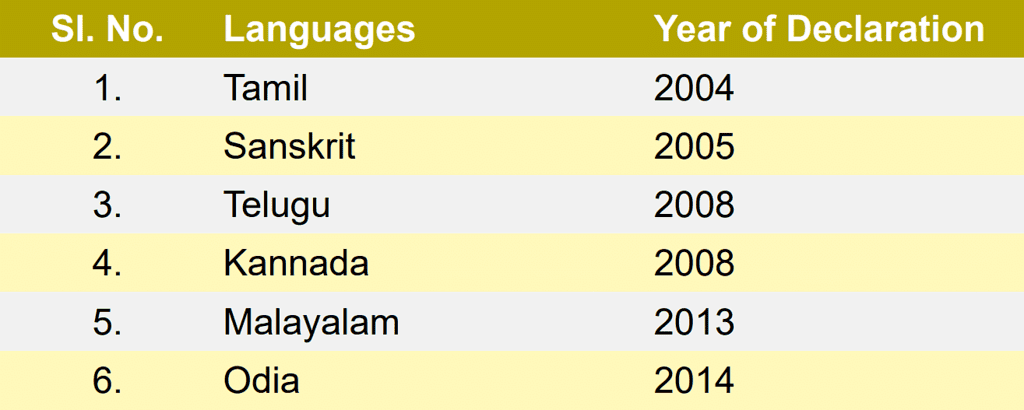
Criteria:
- High antiquity of early texts/recorded history spanning 1,500–2,000 years.
- Possession of a body of ancient literature/texts considered valuable heritage by generations.
- Presence of an original literary tradition not borrowed from another speech community.
- The classical language and literature being distinct from modern, there can also be a discontinuity between the classical language and its later forms or its offshoots.
Benefits:
- Once a language is declared classical, it gets financial assistance for setting up a centre of excellence for the study of that language and also opens up an avenue for two major awards for scholars of eminence.
- Additionally, the University Grants Commission can be requested to establish professional chairs for scholars of classical languages, starting with central universities.
Recent Developments
- The Central government has decided to modify the criteria for granting classical language status.
- The Linguistics Expert Committee comprises representatives of the Union Ministries of Home, Culture and four to five linguistic experts at any given time. It is chaired by the president Sahitya Akademi.
- The new criteria will be officially notified once approved by the Union Cabinet.
- It has delayed the consideration of languages like Marathi for classical status.
- There have been demands from other languages groups to classify their languages as classical language. For example Bengali, Tulu etc.
- According to National Education Policy-2020 works of literature of Pali, Persian, and Prakrit shall also be preserved.
What are the Arguments for Inclusion of Various Languages as Classical Language?
- Bengali
- According to the language family, Bengali is categorised as a Modern or New Indo- Aryan language of the Indo-European language family.
- Bengali alphabets and terms started to appear in the literatures of as early as 10 century AD.
- Since then it had gone through significant stages of development to finally take the present shape.
- However, a panel established by the Bengal government established that Bengali's origin is 2,500 years ago concrete evidence showing its written existence as early as the 3-4 BCE.
- Research indicates that Bengali retains its fundamental syntactic structure, as well as its distinct morphological and phonological patterns, throughout its course of evolution at least from 3.
- Tulu
- Tulu is a Dravidian language spoken mainly in two coastal districts Dakshina Kannada and Udupi of Karnataka and Kasaragod district of Kerala.
- Scholars suggest Tulu is the language that was segregated from the original Dravidian languages some 2,000 years ago and is one of the most highly developed languages of the Dravidian family.
- The language has also been mentioned in the Sangama Literature of Tamil and in Greek Mythology.
- Tulu has a rich oral literature tradition with folk-song forms like paddana, and traditional folk theatre yakshagana.
What are the Constitutional Provisions Related to Language?
- Eighth Schedule
- It was intended to promote the progressive use of Hindi and for the enrichment and promotion of the language.
- Languages in the Eighth Schedule
- The Eighth Schedule to the Constitution consists of the following 22 languages: Assamese, Bengali, Gujarati, Hindi, Kannada, Kashmiri, Konkani, Malayalam, Manipuri, Marathi, Nepali, Oriya, Punjabi, Sanskrit, Sindhi, Tamil, Telugu, Urdu, Bodo, Santhali, Maithili and Dogri.
- Of these languages, 14 were initially included. Sindhi language was added in 1967 (21 Amendment Act). Three more languages Konkani, Manipuri and Nepali were included in 1992 (71 Bodo, Dogri, Maithili and Santhali were added in 2004 (92
- Demands of Languages for Inclusion in the Eighth Schedule
- At present, there are demands for inclusion of 38 more languages in the Eighth Schedule. Example: Angika, Banjara, Bazika, Bhojpuri etc.
- Present Status on Inclusion of Languages in the Eighth Schedule
- As the evolution of dialects and languages is dynamic, influenced by socio eco-political developments, the matter is still under government consideration and the decision will be taken in line with the recommendation of the Pahwa (1996) and Sitakant Mohapatra (2003) Committee.
Language of The Union
- Article 120: Deals with the language to be used in Parliament.
- Article 210: Similar to Article 120 but applies to the State Legislature.
- Article 343: Declares Hindi in Devnagari script as the official language of the Union.
Regional Languages
- Article 345: Allows the state legislature to adopt any official language for the state.
- Article 346: Specifies the official language for communication between states and between states and the Union.
- Article 347: President to recognise any language spoken by a section of the population of a state if demanded.
Special Directives
- Article 29: Protects the interests of minorities. It states that any section of citizens with a distinct language, script, or culture has the right to preserve it.
- Article 350: Ensures that every person has the right to submit a representation for the redress of any grievance in any language used in the Union or the State.
- Article 350A: Directs States to provide adequate facilities for instruction in the mother tongue at the primary stage of education to children belonging to linguistic minority groups.
- Article 350B: Establishes a Special Officer for linguistic minorities appointed by the President, tasked with investigating matters relating to safeguards provided for linguistic minorities under the Constitution.
Mains Question
Discuss the ongoing demand for granting classical language status to various languages in India. Also analyse the implications of such recognitions.
Appointment to Cabinet Committees
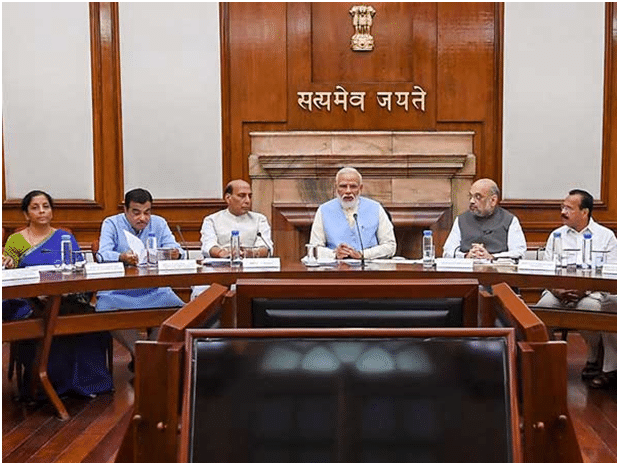
What is a cabinet form of government in a parliamentary democracy?
In a parliamentary democracy, the Cabinet is the highest decision-making body in the government, consisting of the Prime Minister and other senior ministers who are appointed by the head of state, usually a President or Monarch.
- The Cabinet is the pivot around which the whole political machinery revolves.
- Cabinet ministers are typically members of the majority party or coalition in the parliament. The Cabinet is responsible for making and implementing policy decisions, and for coordinating the work of the government.
- Cabinet ministers typically meet regularly to discuss and decide on important issues facing the country. The Cabinet is responsible to the Parliament, and its members are accountable to the Parliament for their actions.
- The concept of cabinet in parliamentary democracy is important as it represents the executive branch of the government, responsible for implementing laws and policies and ensuring the smooth functioning of the administration.
What is the status and role of the cabinet in Indian Polity?
Constitutional Status
- The word 'cabinet' was added to Article 352 of the Constitution in 1978 by the 44th Constitutional Amendment Act.
- It was not present in the original text of the Constitution. Article 352 only mentions the Cabinet as "the council consisting of the Prime Minister and other Ministers of Cabinet rank appointed under Article 75", and does not elaborate on its powers and functions.
- The cabinet's role in the political and administrative system is based on parliamentary government conventions developed in Britain.
Role and Functions of the Cabinet
- The Cabinet in India is the highest authority for decision-making in the country's political and administrative system.
- It serves as the primary body for formulating government policy at the Central level.
- The cabinet is the ultimate executive authority of the central government.
- It also acts as the main coordinator of the Central administration.
- The cabinet acts as an advisory body to the President, and its advice is binding on the President.
- The cabinet is responsible for managing crisis situations and dealing with emergencies.
- It handles significant legislative and financial matters.
- The cabinet exercises control over high-level appointments, such as those for constitutional positions and senior secretariat administrators.
- The cabinet is also responsible for handling all foreign policies and foreign affairs.
Kitchen Cabinet
- The cabinet, a small group made up of the Prime Minister as its leader and several key Ministers, is the highest decision-making body in a formal sense.
- However, an even smaller group known as the "Inner Cabinet" or "Kitchen Cabinet" holds significant power and influence.
- This informal group comprises the Prime Minister and a few trusted colleagues with whom he can discuss important issues and make crucial decisions.
- It may also include outsiders such as friends and family members of the Prime Minister. Almost every Prime Minister in India has had a close group of advisors in the past.
What are the main principles of the cabinet form of government in India?
Principle of Collective Responsibility
- The principle of collective responsibility is a cornerstone of the cabinet form of government.This principle holds that all members of cabinet being members of the Council of Ministers are jointly responsible to the Lok Sabha, meaning they must work as a team and take responsibility for their actions as a group.
- When the Lok Sabha passes a motion of no confidence against the council of ministers, all members of the council including cabinet must resign.
- Additionally, the principle of collective responsibility also means that all cabinet ministers, as well as other ministers, are bound by decisions made by the Cabinet, even if they disagreed with them during the Cabinet meeting.
Principle of Individual Responsibility
- In addition to the principle of collective responsibility, Article 75 also includes the principle of individual responsibility.
- Individual responsibility means that cabinet ministers also serve at the pleasure of the President and can be removed by the President at any time, regardless of whether the council of ministers has the confidence of the Lok Sabha.
- However, such a removal would only occur on the advice of the Prime Minister. If the Prime Minister has a difference of opinion or is unhappy with the cabinet minister's performance, he/she can request the resignation of the Cabinet Minister or advise the President to dismiss him/her.
Central role of the Prime Minister
- A prime minister is the head of the cabinet and the leader of the ministers in the executive branch of government, often in a parliamentary system. He/She presides over the meetings of the Cabinet.
- The Prime Minister can ask the President to reshuffle the portfolios of Cabinet Ministers.
- The Prime Minister can impose his/her decision if there is any difference of opinion between the Prime Minister and other Cabinet Ministers.
- The Prime Minister acts as a linchpin between the President and cabinet. He communicates the decisions of the Cabinet to the President.
Political Homogeneity
- Political homogeneity in a parliamentary system refers to a situation where all cabinet members are from the same political party.
- Political homogeneity allows for efficient decision-making by the ruling government officials, who are held accountable for policies and actions within the legislature.
- Conversely, in a coalition government, where no single party holds power, political homogeneity is reduced.
What are cabinet committees?
Cabinet committees are extra-constitutional in nature. They are not mentioned in the Constitution. However, These are established under the Rules of Business.
- Cabinet committees are of two types–standing and ad hoc. Standing committees are of a permanent nature, while the latter is of a temporary nature. Ad hoc committees are established from time to time to deal with special problems.
- Cabinet committees are set up by the Prime Minister according to the exigencies of the time and requirements of the situation. Hence, their number, nomenclature, and composition vary from time to time.
- They not only sort out issues and formulate proposals for the consideration of the Cabinet but also make decisions. However, the Cabinet can review their decisions.
- They are an organizational device to reduce the enormous workload of the Cabinet. They also facilitate in-depth examination of policy issues and effective coordination. They are based on the principles of division of labour and effective delegation.
What are the different Cabinet committees in India and their composition?
Classification
There is a total of eight cabinet committees which are as listed below:
- Appointments Committee of the Cabinet.
- Cabinet Committee on Economic Affairs.
- Cabinet Committee on Political Affairs.
- Cabinet Committee on Investment and Growth.
- Cabinet Committee on Security.
- Cabinet Committee on Parliamentary Affairs.
- Cabinet Committee on Employment & Skill Development.
- Cabinet Committee on Accommodation.
Composition
The composition of cabinet committees in India can range from three to eight members, which typically consist of only Cabinet Ministers.
- However, non-cabinet ministers may also be appointed as members. Additionally, senior ministers, who are not in charge of the subjects discussed in the committee, may also be included.
- The Prime Minister usually chairs the committee, but in some cases, other Cabinet ministers such as the Home Minister or the Finance Minister may assume the role. However, If the Prime Minister is a committee member, he will be the head of the committee.
- In the present scenario, All committees except Cabinet Committee on Accommodation and Cabinet Committee on Parliamentary Affairs are usually headed by the Prime Minister.
- Moreover, the Cabinet Committee on Accommodation is headed by the Home Minister and Cabinet Committee on Parliamentary Affairs is headed by the Defence Minister.
Extension of Smart Cities Mission
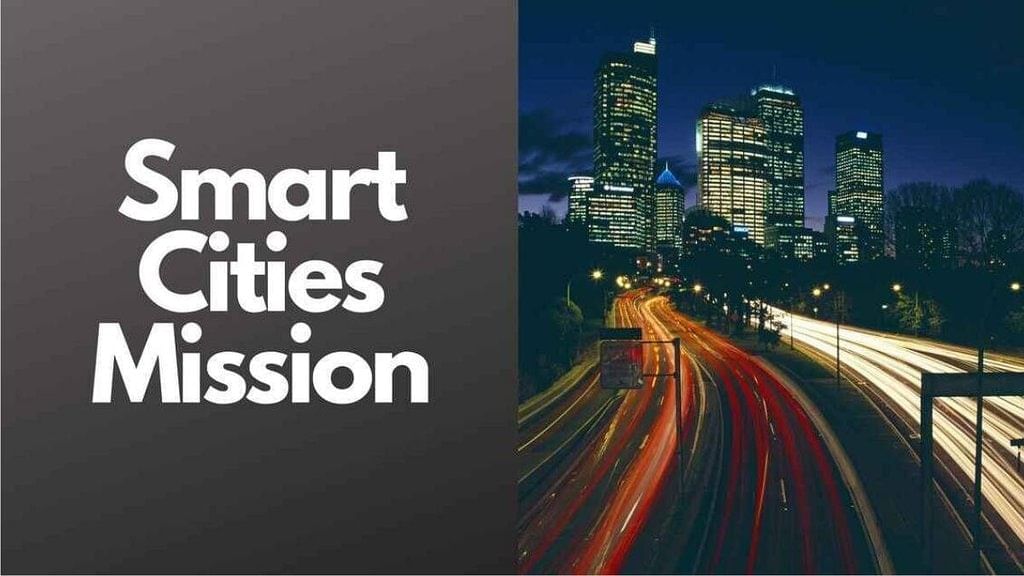 Why in news?
Why in news?
Recently, the Central Government has decided to extend the deadline for till 31st March 2025. Initially planned for completion by 2020, the mission had already been extended twice.
What is the Smart Cities Mission (SCM)?
About:
- It is a Centrally Sponsored Scheme launched in June 2015 to transform 100 cities to provide the necessary core infrastructure and clean and sustainable environment to enable a decent quality of life to their citizens through the application of "Smart Solutions".
- It aimed to improve the quality of life for citizens through sustainable and inclusive development.
Components of the SCM
Area-based Development:
- Redevelopment (City Renewal): Redevelopment of existing urban areas to improve infrastructure and amenities. Example: Bhendi Bazar, Mumbai.
- Retrofitting (City Improvement): Upgrading infrastructure in existing areas to make them more efficient and sustainable. Example: Local Area Development (Ahmedabad).
- Greenfield Projects (City Extension): Development of new urban areas with a focus on sustainability and smart technologies. Example: New Town, Kolkata, Naya Raipur, GIFT City (Gujarat International Finance Tec-City).
Pan-City Solutions:
- Implementation of Information and Communication Technology (ICT) solutions across various sectors such as e-governance, waste management, water management, energy management, urban mobility, and skill development.
Governance Structure:
- To enhance effectiveness, a new governance model was adopted.
- Special Purpose Vehicle (SPV) was created under the Companies Act, 2013 led by a bureaucrat or a representative of a Multinational Corporations (MNC).
Financing of Smart Cities:
- The SCM receives Rs. 48,000 crores over 5 years from the Central Government, averaging Rs. 100 crore per city per year.
- States and Urban Local Bodies (ULB) are required to contribute an equal amount, resulting in a total of nearly Rs. 1 lakh crore for Smart Cities development.
Convergence with Other Government Schemes:
- The SCM can be strategically converged with other Central and State Government programs to utilise its full potential.
Benefits of Convergence:
- Combining resources and objectives of SCM with schemes like AMRUT (urban transformation), Swachh Bharat Mission (cleanliness), HRIDAY (heritage city development), Digital India, Skill Development, Housing for All leads to a more comprehensive approach.
- Existing funds and infrastructure from various schemes can be leveraged to achieve common goals within the SCM framework.
- Convergence ensures social infrastructure (health, education, culture) is addressed alongside physical infrastructure development in smart cities.
What are the Challenges Faced by the Smart Cities Mission?
- Lack of Clarity in Definition: The SCM has acknowledged the lack of a universal definition for the term "smart city."
- Delay in Project Completion: Despite the extension of the deadline, a significant number of projects (around 10%) are still incomplete, indicating delays in execution.
- Inadequate Funding and Its Utilisation: While 74 cities have received 100% of their central share, 26 cities are yet to get the full funding due to the slow progress of projects.
- Lack of Coordination: Effective coordination between the central, state, and local governments has been a challenge due to differences in priorities, bureaucratic hurdles, lack of clarity in roles and responsibilities.
- Sustainability Concerns: There are doubts about the long-term sustainability of the smart city projects, as many of them focus on technology-driven solutions rather than addressing the fundamental issues of urban planning and governance.
- Displacement and Social Impact: According to the World Bank, in urban areas of India more than 49% of the population live in slums.
- The execution of smart city projects has led to the displacement of residents in poorer areas, such as street vendors, disrupting the fabric of urban communities.
What Should be the Steps Taken to Strengthen Smart Cities Mission?
- Effective Governance and Implementation: Appointing CEOs with fixed tenures ensures continuity and attracts qualified professionals.
- Strategic Project Focus: The SCM digital infrastructure is expected to generate and utilise vast amounts of data from diverse sources.
- Data Security and Upgradation:
- Establish robust digital infrastructure protection to counter cyber threats and safeguard data privacy.
- Develop comprehensive Operation and Maintenance (O&M) strategies to maximise infrastructure lifespan and ensure timely upgrades.
- Building Capacity and Funding: Urban Local Bodies (ULBs) in smaller cities through capacity building programs.
- Ensuring Project Completion: The Ministry's role should extend beyond fund allocation.
- Global Knowledge Sharing: India's focus on sustainable urban development positions it to guide similar projects in developing nations (Example: Gelephu Smart City Project, Bhutan).
Mains Question
What is the Smart Cities Mission? What are the challenges faced by this and suggest the measures to address these challenges.
Issue of Urban Finance and 16th Finance Commission

Why in News?
Recently, developments concerning the Finance Commission (FC) in India highlight critical issues regarding fiscal decentralisation, particularly focusing on urban areas and their financial sustainability within the federal structure. The World Bank has estimated that USD 840 billion is needed for basic urban infrastructure in the next decade.
What are the Financial Sustainability Issues with the Urban Areas?
- Urbanisation Challenges: India's urban areas, which contribute 66% of India's GDP and about 90% of total government revenues face immense infrastructure and financial challenges. Despite being crucial economic hubs, cities receive inadequate fiscal support intergovernmental transfers (IGTs) constituting only 0.5% of GDP impacting their ability to provide essential services and maintain infrastructure.
- Financial Devolution Issues: The devolution of funds to Urban Local Bodies (ULBs) is significantly lower than other developing nations.
- This shortfall affects urban productivity and quality of life, exacerbated by the introduction of the Goods and Service Tax (GST), which has reduced ULBs' own tax revenues.
- Draining Resources: An RBI survey of 221 municipal corporations (2020-21) revealed that more than 70% of these corporations saw a decline in revenues while in contrast, their expenditure rose by almost 71.2%. The RBI report also highlights the limited coverage of property tax and its failure in shoring up municipal corporation revenues.
- Decline in Grants: Experts argue that GST not only ended octroi but also severely impacted the businesses of many small entrepreneurs, resulting in a significant decline in tax revenue for urban local bodies. Previously almost 55% of the total revenue expenditure of urban centres was met by octroi which has now significantly reduced.
Other Issues
- Census Data Concerns: The absence of updated census data (since 2011) poses a challenge in accurately assessing the urban population and its needs. This outdated data affects evidence-based fiscal devolution planning, crucial for addressing the dynamic urbanisation trends, including migration to Tier-2 and 3 cities.
- Policy Distortions: Parallel agencies and schemes, such as MP/MLA Local Area Development Funds, undermine the financial autonomy of local governments, distorting the intended federal structure and complicating urban governance and service delivery.
- Lesser Functional Autonomy: During the pandemic, the leaders at national, state and district level were seen taking a call on disaster mitigation strategies, however, the heads of municipal corporations were not included in this group. The old approach of treating local governments as adjuncts of State governments continues to dominate the policy paradigm.
- Structural Issues: Some of the urban local governments do not have basic infrastructure and human resources. While in some states regular elections are not conducted for the local bodies.
What are the Major Terms of Reference for the 16th Finance Commission?
About:
- Finance Commission in India is a constitutional body established under Article 280 of the Indian Constitution. Its primary function is to recommend the distribution of financial resources between the central government and the state governments.
- Fifteenth Finance Commission: was constituted in 2017. It made recommendations covering the period of six years commencing on 1 April, 2020 through its Interim and Final Reports. The recommendations of the Fifteenth Finance Commission are valid up to the financial year 2025-26.
Terms of Reference:
- Division of Tax Proceeds: Recommending the distribution of taxes between the Union Government and the States under Chapter I of the Constitution. This includes the allocation of shares among the States from these tax proceeds.
- Principles for Grants-in-Aid: Establishing the principles governing grants-in-aid to the States from the Consolidated Fund of India. This encompasses determining the amounts to be provided to the States as grants-in-aid, specifically under Article 275 of the Constitution.
- Enhancing State Funds for Local Bodies: Identifying measures to enhance the Consolidated Fund of a State. This is aimed at supplementing the resources available to Panchayats and Municipalities within the State, based on recommendations made by the State's own Finance Commission.
- Evaluation of Disaster Management Financing: The Commission may review the current financing structures related to Disaster Management initiatives. This involves examining the funds created under the Disaster Management Act, 2005, and presenting suitable recommendations for improvements or alterations.
What are the Steps Needed for Better Urban Finance?
- Strengthening Municipal Revenue: All Finance Commissions have recognised the need to augment property tax revenue to improve municipal finances.
- Modernise Tax Administration: Outdated systems lead to inefficiencies and leakages. Local bodies can implement digital platforms for property tax assessment, e-filing, and online payments.
- Explore User Charges for Specific Services: Instead of a blanket tax structure, some services can have user charges.
- Strategic Property Management: Local bodies often hold underutilised properties. These can be monetised through public-private partnerships (PPP) for developing commercial spaces, markets, or parking lots.
- Promote Local Businesses and Economic Development: A thriving local economy translates to higher tax revenue for local bodies.
- Explore Social Stock Exchange (SSE): These exchanges allow social enterprises, which focus on social impact alongside profit generation, to raise capital.
- Implement Value Capture Mechanisms: This involves capturing a portion of the increased value of private properties resulting from public infrastructure projects.
Conclusion
The ongoing work of the 16th Finance Commission is pivotal in addressing these challenges by revisiting fiscal devolution principles, updating methodologies based on current urbanisation dynamics, and recommending substantial increases in IGTs to urban areas. The implications of these recommendations will be far-reaching, impacting India's economic growth trajectory, social equity goals, and environmental sustainability efforts in its urban centers. Effective implementation will require concerted efforts from Union and State governments to align policies and ensure sustainable urban development in the country.
Allahabad HC on Religious Conversions
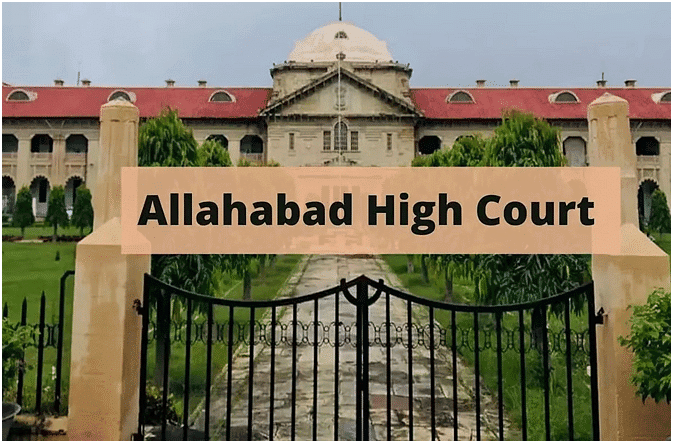
Why in News?
The recent focus of the Allahabad High Court was on the issue of religious conversions in India, particularly noting the potential demographic consequences on the majority populace. This attention arose in the context of rejecting a bail plea from an individual charged under the Uttar Pradesh Prohibition of Unlawful Conversion of Religion Act, 2021, and pertinent sections of the Indian Penal Code. The case underscores the court's position on the constitutional limits of religious propagation and the pressing necessity to restrain illegal conversion activities.
Dimensions of the Article
- The Allahabad High Court highlighted several crucial observations concerning religious conversions.
- Freedom of Religion in our Constitution: The court emphasized that while Article 25 of the Indian Constitution guarantees freedom of religion, it allows for the promotion of religion but does not explicitly sanction conversions.
- Meaning of Propagation: It clarified that 'propagation' entails promoting a religion but doesn't encompass converting individuals from one faith to another.
- Concerns on Demographic Shifts: Unrestricted conversions could result in demographic alterations, potentially transforming the majority population into a minority in India.
- Focus on Vulnerable Groups: There was a specific emphasis on rampant illegal conversions targeting Scheduled Castes (SCs), Scheduled Tribes (STs), and economically disadvantaged individuals in Uttar Pradesh.
Recommendations
- The court suggested an immediate halt to religious congregations where conversions are occurring to effectively address these concerns.
The right to freedom of faith is not a conferred right but a natural entitlement of every human being. In fact, the law does not assign it but it asserts, protects and ensures its entitlement. Indian Society has nurtured almost all the established religions of the world like Hinduism, Islam, Christianity, Buddhism, Jainism, Sikhism, etc., from time immemorial.
- Article 25: All individuals are equally entitled to 'freedom of conscience and the right freely to profess, practice and propagate religion,' subject to public order, morality, health, and the other fundamental rights guaranteed in the Constitution.
- Article 26: It grants every religious group the right to establish and maintain institutions for religious and charitable purposes, manage its affairs and properties as per the law. This guarantee is accessible only to Citizens of India and not to aliens.
- Article 27: This Article mandates that no citizen can be compelled by the state to pay taxes for promoting or maintaining a particular religion or religious denomination.
- Article 28: This Article mandates that NO religious instruction would be imparted in state-funded educational institutions.
Religious conversion has always been a sensitive social issue due to psychological concerns of religious faith and broader socio-legal and socio-political implications.
Religious conversion involves adopting a new religion, one different from the individual's previous religion or religion by birth.
Reasons for Religious Conversions:
- Conversion by free will or free choice
- Conversion due to a change of beliefs
- Conversion for convenience
- Conversion due to marriage
- Conversion by force
Religious Conversion is a multifaceted and multi-dimensional phenomenon. Indian society is pluralistic and heterogeneous, with diverse races, religions, cultures, castes, and languages. Religious Conversion has always been a contentious issue in India.
Reasons for religious conversions in India include
- Rigid Hindu caste system
- Polygamy prevalent in Islam
- To avail reservation benefits
- To date, there are no central legislations restricting or regulating religious conversions.
- In 2015, the Union Law Ministry stated that Parliament lacks the legislative competence to pass an anti-conversion legislation.
- Apart from Uttar Pradesh and Gujarat, Madhya Pradesh and Himachal Pradesh have also enacted similar laws.
- In 1967-68, Orissa and Madhya Pradesh enacted local laws named the Orissa Freedom of Religion Act 1967 and the Madhya Pradesh Dharma Swatantra Adhiniyam 1968. Chhattisgarh inherited the law from Madhya Pradesh.
- The Arunachal Pradesh Freedom of Religion Act, 1978, was enacted to prohibit forced conversion from one religious faith to another by using force or inducement.
- The Tamil Nadu Prohibition of Forcible Conversion of Religion Ordinance was promulgated in 2002 and subsequently repealed in 2004.
- The Rajasthan Assembly passed an Act in 2006, awaiting Presidential assent.
- Uttar Pradesh Prohibition of Unlawful Religious Conversion Ordinance, 2020: The law makes conversion non-bailable with up to 10 years of imprisonment if done unlawfully and necessitates district magistrate approval for religious conversions for marriage in Uttar Pradesh.
- Gujarat Freedom of Religion (Amendment) Act, 2021, aligns with similar laws enacted in 2020 by BJP-ruled states, aiming to prevent conversion through unlawful means, particularly prohibiting conversion for marriage without prior state sanction.
- The new anti-conversion laws shift the burden of proof of a lawful religious conversion from the converted individual to their partner.
- Legal experts note that these laws infringe on an individual's agency to marry someone of a different faith and to choose to convert from one's religion for that purpose.
- The freedom to propagate one's religion and the right to choose a partner are fundamental rights impacted by the new anti-conversion laws.
- Lata Singh Case 1994: The apex court emphasized the importance of accepting the plurality and diversity of Indian culture to maintain the strength of the Constitution.
- Hadiya Judgement 2017: The court highlighted that matters like love, partnership, and choice of partners are central to an individual's identity and cannot be dictated by the state or law.
- Soni Gerry case, 2018: The Supreme Court warned against judges acting as 'super-guardians' and interfering in personal matters.
- Salamat Ansari-Priyanka Kharwar case (Allahabad HC) 2020: The court reiterated the right to choose a partner as part of an individual's fundamental right to life and liberty (Article 21).
High Court Upholds Hijab Ban in Colleges
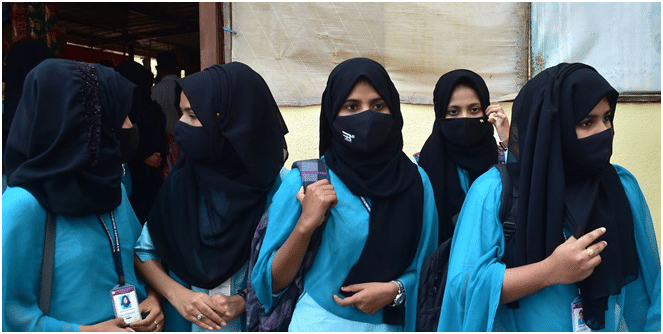
Why in News?
Recently, the Bombay High Court dismissed a plea from 9 students challenging the college's new dress code, which banned hijabs, burqas, niqabs, and other religious symbols on campus. The court justified the dress code as being in the "larger academic interest" of the students.
Dimensions of the Article
Key Arguments and Court's Ruling
- Students claimed the dress code violated their religious freedom and right to education.
- They argued that the restrictions impeded educational access for minority communities.
- Students referenced specific constitutional articles like Article 19(1)(a) and Article 25.
Bombay High Court's Ruling
- The court emphasized that the dress code applied uniformly to all students.
- It held that the dress code did not violate UGC regulations promoting equity in higher education.
- The court supported the 2022 Karnataka High Court judgement regarding hijabs.
Way Forward
- Aligning High Court judgements may indicate an emerging judicial trend.
- The Supreme Court's decision will be pivotal in establishing a clear legal framework.
- Clear policies from the UGC are necessary to ensure uniformity and protect fundamental rights.
- Formulating dress codes through a consultative process is essential for inclusivity.
|
173 videos|574 docs|148 tests
|

















